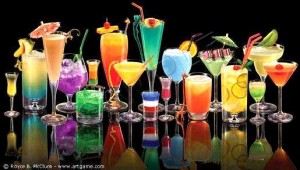 “I couldn’t discipline him, because he wasn’t acting up. He was drunk.”
“I couldn’t discipline him, because he wasn’t acting up. He was drunk.”
That from the mother of little Niko van Heest, a 15-month-old who was allegedly served sangria at Olive Garden this week, just days after a Michigan toddler actually got quite shitfaced when Applebee’s served him margarita instead of apple juice.
Little margarita-man’s family is now suing Applebee’s, which has preemptively ordered that all its 10 billion waitstaff now have to pour juice drinks at the table from unopened single-serve containers to soothe the panics of a stricken nation.
Whatever the outcome of that grabby little lawsuit, though, Applebee’s corporate HQ isn’t the only one to blame here. It’s also on us.
Which us? Why, us, the nation of rejuveniles who insist on consuming our alcohol in the kind of brightly colored, fruit-flavored concoctions that toddlers are evolutionarily drawn to.
That’s the untold story of the Applebuzz controversy: why the hell was a toddler even able to swallow one sip of an adult’s drink, much less a whole cup of it? If it was an actual drink, the kind that isn’t dusted with confectioners sugar or injected with FD&C Yellow 5, a toddler wouldn’t have had a chance of actually making it through a whole cup.
One of my favorite souvenirs from my last trip to Cuba is a kind of street-grade rum called Planchao (literally “ironed”, akin to “smashed”) that is sold in the same kind of small, brightly colored tetrapak that any American parents would recognize as a juice box. I shared one of them in the Cancun airport on the way home with an American who was going to medical school in Cuba; the other is still in my kitchen. Despite its playful look, I’m not worried for a second about it actually being imbibed by my kids. That’s because the drink inside that box is far from the kind of cloying, viscous drink that passes for a cocktail these days. Rather, it’s straight rotgut. Solvent. Astringent. Rum. Planchao. A child couldn’t get within a foot of that stuff in real life without having some sort of terrified reaction, as if they had happened upon a scene of death or sex or something else that renders them mute and wounded.
At least, that’s how I imagine they would react. The planchao has stayed in its box thus far. But I have had that same experience when my kids keened for the alcoholic drinks I may be drinking in their presence. A sip of beer, they handled fine–though they certainly won’t be seeking it out until they are, say, in the third grade. But when I was drinking whiskey, or, especially, brandy, their curiosity turned to physical discomfort the closer they got to the glass.
That’s how it’s supposed to be. But suppose they got served one of the 700-calorie happy hour offerings from any of our nation’s casual dining chains? They would be in a bind. My five-year-old girl especially is addicted to sugar in a way that would make her stay in that drink no matter what faint taste of grain or cane spirit lay beneath.
I’m not trying to brag about how cirrhotic and pure my own drinking choices are. I have been photographed at least once with a glass of Rosé; I’ll admit a weakness for mojitos in the right moments of nostalgia. But I also know this: the harder the alcohol I drink, the safer my family is.

How much is the lawsuit for? Maybe it’s only the price of the drink … doubt it. Probably millions, because everyone should pay millions for a mistake like that! Yeah right.
Just checked the amount .. it’s unspecified. Apparently the kid was out for days with a 0.1 blood alcohol. That’s not crazy drunk. Way too drunk to drink, but he shouldn’t be unconscious. Maybe toddlers can handle booze like a grownup.
On another note — hope you don’t mind me sharing — I just wrote about Cannibal blue lobsters and drowning squirrels.